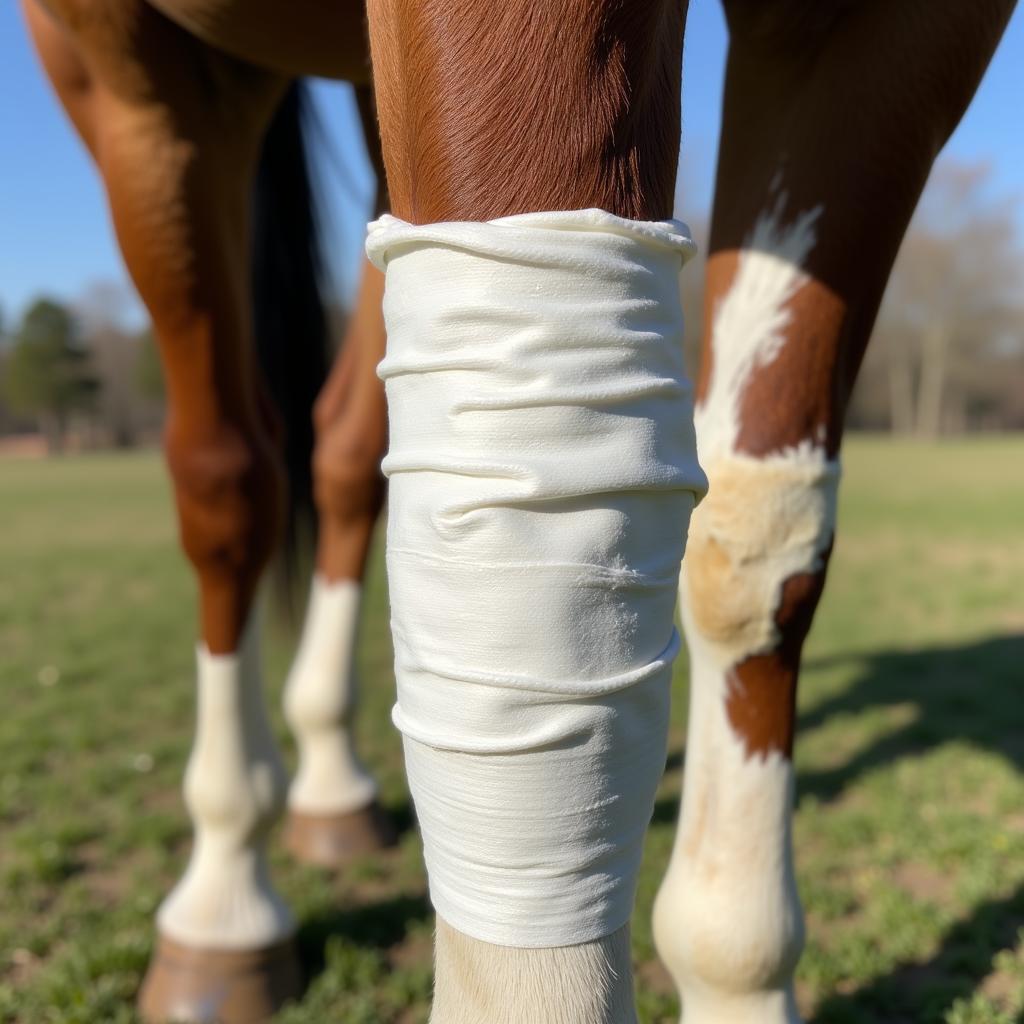A poultice is a common treatment method used to address various lower leg ailments in horses. It involves applying a moist, absorbent material to the affected area, which helps draw out heat, reduce inflammation, and promote healing. Whether you’re dealing with an abscess, tendonitis, or a minor wound, understanding how to properly apply and manage a poultice can be invaluable for any horse owner.
What Exactly is a Poultice for Horses?
Essentially, it’s a therapeutic paste or pack applied to your horse’s legs. Its main purpose is to draw out heat and inflammation, often caused by injuries. Think of it like a warm compress for humans, but specifically designed for equine needs.
Why Use a Poultice?
There are various reasons why veterinarians recommend Poultice For Horses:
- Abscesses: A poultice helps draw out the infection and soften the abscess, encouraging it to rupture and drain.
- Tendonitis and Strains: The anti-inflammatory properties of a poultice can help reduce swelling and pain associated with tendon and ligament injuries.
- Bruising and Swelling: A poultice can help reduce bruising and swelling caused by trauma to the lower leg.
- Wound Healing: Some types of poultice have antiseptic properties that can promote wound healing.
Types of Horse Poultice
You’ll find a variety of poultice options available, each with its unique properties and benefits:
- Clay-based Poultice: This type of poultice is known for its strong drawing power, making it effective for abscesses.
- Epsom Salt Poultice: Epsom salt poultice for horses is a popular choice for reducing inflammation and drawing out fluid.
- Commercial Poultice Products: Various ready-to-use poultice products are available, often combining different ingredients for specific purposes.
How to Apply Poultice to Your Horse
Proper application is crucial for effective treatment. Here’s a step-by-step guide:
- Clean the Affected Area: Thoroughly clean the horse’s leg with warm water and antiseptic soap, ensuring all dirt and debris are removed.
- Apply the Poultice: Apply a generous layer of poultice to the affected area, ensuring complete coverage. The thickness should be about half an inch to an inch.
- Secure with a Wrap: Wrap the poultice securely with a layer of gauze or a clean cotton wrap, followed by a layer of vet wrap or standing bandages. The wrap should be snug but not too tight to restrict circulation.
- Leave On for the Recommended Time: The duration for leaving the poultice on varies depending on the type of poultice and the specific condition. Always follow your veterinarian’s instructions.
- Remove and Clean: Carefully remove the wrap and poultice. If the poultice has hardened, soak it with warm water before removal to avoid irritating the skin. Clean the area again with warm water and antiseptic soap.
Cautions and Considerations
While poultice can be highly beneficial, it’s essential to use it with caution:
- Consult Your Veterinarian: Always consult your veterinarian before using any poultice on your horse, especially if the condition is severe or you suspect an infection.
- Monitor for Irritation: Some horses may be sensitive to certain ingredients in poultice. Monitor your horse for any signs of irritation, such as redness, swelling, or discomfort.
- Do Not Reuse Poultice: Always use fresh poultice for each application. Reusing poultice can introduce bacteria and hinder the healing process.
 Bandaging After Poultice Application
Bandaging After Poultice Application
Frequently Asked Questions About Poultice for Horses
Q: How long does it take for a poultice to work on an abscess?
A: The time can vary, but it typically takes a few days to a week for a poultice to draw out an abscess and encourage it to rupture.
Q: Can I use a human heating pad instead of a poultice?
A: It’s not recommended to use a human heating pad on a horse. These pads can get too hot and may burn your horse’s skin.
Q: Can I make my own poultice at home?
A: While there are recipes for homemade poultice, it’s generally recommended to use commercially prepared products to ensure the correct consistency and sterility.
Q: How often should I change the poultice?
A: The frequency of changing the poultice depends on the type of poultice and your veterinarian’s instructions. It’s typically changed every 12-24 hours.
Q: What are the signs that the poultice is working?
A: Signs that the poultice is working include reduced swelling, heat, and pain in the affected area. For abscesses, you may also see drainage.
Need More Help with Your Horse’s Health?
For additional resources on caring for your equine companion, explore our articles on salt lick horses and Elastikon tape for horses.
Remember, early detection and prompt treatment are crucial for a successful recovery. If you have any concerns about your horse’s health, always contact your veterinarian immediately.
For personalized advice and support, don’t hesitate to contact Justus Horses USA. Our team is available 24/7 to assist you. You can reach us at 0772127271 or email us at [email protected]. We are located at QGM2+WX2, Vị Trung, Vị Thuỷ, Hậu Giang, Việt Nam.